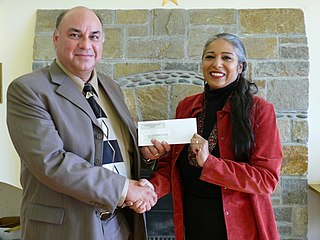
Deception Pass is a strait separating Whidbey Island from Fidalgo Island, in the northwest part of the U.S. state of Washington. It connects Skagit Bay, part of Puget Sound, with the Strait of Juan de Fuca. A pair of bridges known collectively as Deception Pass Bridge cross Deception Pass. The bridges were added to the National Register of Historic Places in 1982.

Whidbey Island is the largest of the islands composing Island County, Washington, in the United States, and the largest island in Washington State. Whidbey is about 30 miles (48 km) north of Seattle, and lies between the Olympic Peninsula and the I-5 corridor of western Washington. The island forms the northern boundary of Puget Sound. It is home to Naval Air Station Whidbey Island. The state parks and natural forests are home to numerous old growth trees.

The Pequot are a Native American people of Connecticut. The modern Pequot are members of the federally recognized Mashantucket Pequot Tribe, four other state-recognized groups in Connecticut including the Eastern Pequot Tribal Nation, or the Brothertown Indians of Wisconsin. They historically spoke Pequot, a dialect of the Mohegan-Pequot language, which became extinct by the early 20th century. Some tribal members are undertaking revival efforts.

The Wampanoag, also rendered Wôpanâak, are a Native American people and an Indigenous people of the Northeastern Woodlands based in southeastern Massachusetts and historically parts of eastern Rhode Island, Their territory included the islands of Martha's Vineyard and Nantucket.

The Narragansett people are an Algonquian American Indian tribe from Rhode Island. Today, Narragansett people are enrolled in the federally recognized Narragansett Indian Tribe. They gained federal recognition in 1983.

The Pokanoket was the village governed by Massasoit. The term broadened to refer to all peoples and lands governed by Massasoit and his successors, which were part of the Wampanoag people in what is now Rhode Island and Massachusetts.
Lushootseed, also Puget Salish, Puget Sound Salish or Skagit-Nisqually, is a language made up of a dialect continuum of several Salish tribes of modern-day Washington state. Lushootseed is one of the Coast Salish languages. The latter is one of two main divisions of the Salishan language family.
The Snohomish are a Lushootseed Native American tribe who reside around the Puget Sound area of Washington, north of Seattle. They speak the Lushootseed language. The tribal spelling of their name is Sdoh-doh-hohbsh, which means "lowland people" according to the last chief of the Snohomish tribe, Chief William Shelton. Some commentators believe a more accurate spelling in the Latin alphabet would be Sdohobich, as their language has no nasal consonants.

Mukilteo Lighthouse Park encompasses the lighthouse at the west end of the city of Mukilteo, Washington, and 12 acres (0.049 km2) south of it. The property is west and south of the Washington State Ferries terminal with ferry service to Clinton, Whidbey Island, and is bordered on the south and east by the BNSF Railway mainline. Whidbey Island lies across a narrow portion of Possession Sound and is easily visible from the shore.
The Minnesota Indian Affairs Council (MIAC) is a state-level government agency created by the Minnesota Legislature in 1963 to provide a liaison between the government of Minnesota and the American Indian tribes in the state. The council also brings issues of concern to Indians living in urban areas to the attention of the state government. It was the first state-level Indian affairs agency to be established in the United States.
A tribal chief or chieftain is the leader of a tribal society or chiefdom.
In the United States, an American Indian tribe, Native American tribe, Alaska Native village, tribal nation, or similar concept is any extant or historical clan, tribe, band, nation, or other group or community of Native Americans in the United States. Modern forms of these entities are often associated with land or territory of an Indian reservation. "Federally recognized Indian tribe" is a legal term of art in United States law with a specific meaning.

American Indian tribal recognition in the United States most often refers to the process of a tribe being recognized by the United States federal government, or to a person being granted membership to a federally recognized tribe. There are 574 federally recognized tribal governments in the United States. Non-Acknowledged Tribes are tribes which have no federal designation as sovereign entities. This is not to be confused with recognition of Native Americans in the US which are defined by the BIA as any descendant of the Indigenous peoples of the Americas which is a US citizen. Federally Non-Recognized tribes refers to a subgroup of non-acknowledged tribes which had some sort of recognition by the British prior to the formation of the United States or by the United States but which were determined by the government to no longer exist as an Indian tribe or no longer meet the criteria for a nation to nation status.
The Lower Skagit are a tribe of the Lushootseed Native American people living in the U.S. state of Washington. Today they are enrolled in the federally recognized tribe, the Swinomish Indians of the Swinomish Reservation.

Native American tribes in Massachusetts are the Native American tribes and their reservations that existed historically and those that still exist today in what is now the Commonwealth of Massachusetts. A Narragansett term for this region is Ninnimissinuok.

The Samish Indian Nation is a Coast Salish nation and a signatory to the Treaty of Point Elliott of 1855. Samish has a government-to-government relationship with the United States of America. The Samish are a Northern Straits branch of Central Coast Salish peoples. The Samish Nation is headquartered in Anacortes, Fidalgo Island, in Washington, north of Puget Sound.

The land that is now the State of Maryland in the United States of America was widely populated by indigenous tribes prior to European arrival, however only 1.0% of the state's population self-reported as Native American in the 2010 United States Census. Native Americans have inhabited the area since c. 10,000 BC.










